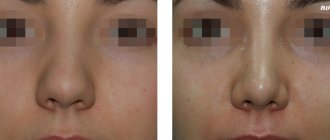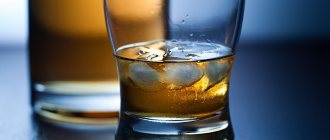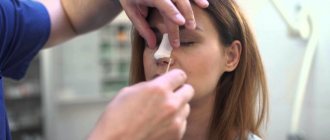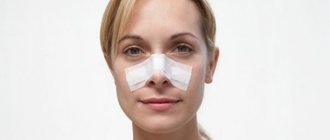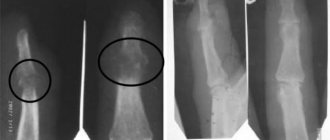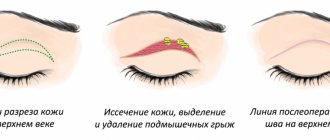Even a brilliantly performed rhinoplasty can be ruined by the correct behavior and disobedience of the patient during the rehabilitation period. What can and cannot be done after rhinoplasty?
If you have not had rhinoplasty yet, be sure to read our article about the preparation and features of this operation.
The first days after the procedure are very important:
- You cannot remove tampons from your nose yourself, even for a very short time. If they cause great inconvenience, you need to be patient.
- The outer lining also cannot be removed independently, since it will no longer be possible to return it to its previous position. It maintains the new shape of the nose; if the bandage is removed earlier than two weeks, complications may arise. In certain cases (with a slow healing process, as well as during complex operations), the bandage must be worn even longer.
- You can only sleep on your back with your head slightly raised on a high pillow. You can't sleep on your side.
If you have already had rhinoplasty , then you will be interested in the article “How many days after rhinoplasty is the cast removed?”
Why can’t you wear glasses and touch the stitches after rhinoplasty?
When the bandage is removed, even a light touch to the stitches can lead to deformation of the scar and infection. Therefore, at first you can touch your nose, but very carefully and not where the stitches are.
You can't wear glasses for about one and a half to two months. They put pressure on the bridge of the nose, as a result of which its shape may change.
If your vision is poor, you may want to consider purchasing contact lenses to wear until you can wear glasses.
How to properly and carefully care for your face after rhinoplasty?
Deep facial cleansing should not be done after rhinoplasty for at least a month. To cleanse the skin, it is best to use gentle cosmetics.
Sometimes the question arises: is it permissible to massage the nose? If after surgery a small hump of cartilaginous origin appears, the doctor may prescribe several massage sessions. In this case, the facial skin should be smeared only with those ointments that were prescribed by the doctor.
Is it possible to rinse the nose and what is the best way to do it after surgery? You can wash it, but you need to do it correctly. It is best to consult with your plastic surgeon so that he can give recommendations regarding the choice of the right products and the intensity of the process. In normal cases, the following rules apply:
You should start rinsing your nose 3-4 days after surgery. Usually at this time the tampons are already removed.
In the first month after the procedure, it is best to do this three times a day with a weak saline solution or other means that are based on sea water. If after a month there is still a feeling of congestion or discomfort, you can extend the rinsing period.
How to rinse your nose correctly?
- Gently tilt your head slightly to the side over the sink.
- Take a deep breath. Then hold your breath for a while.
- Rinse the left nostril with a special pipette. After that, it is very easy to blow out the contents of the nose. It is important to do this very slowly, slightly blowing air and keeping your mouth open. You should not pinch the wing of your nose, but rather carefully close the right nostril with the pad of your finger.
- Then you should also rinse the right nostril.
After rinsing, of essential oils such as sea buckthorn, peach or apricot into your nose
Using rinsing, you can clean your nose well, which helps:
- reduce swelling or inflammation,
- restore blood vessels to their former elasticity,
- speed up the process of tissue repair,
- moisturize the mucous membrane in a timely manner and
- free the intranasal passages from dried blood and postoperative crusts.
- As a result, everything heals faster and breathing improves.
Reminder! When it comes to rinsing your nose, it is very important to follow your doctor's recommendations exactly.
First days
It is especially important to monitor and care for your nose during the first month after surgery. On the first day, the patient is monitored by a surgeon who assesses the patient’s condition after the procedure.
After rhinoplasty:
- On the second or third day, remove the tampons,
remove the splints from the nose and remove the bandages. It is better to do this with a doctor, since this action can be painful, with the use of painkillers. - After surgery, treat
the inside of the nostrils with sterile cotton swabs with the addition of hydrogen peroxide. This procedure is necessary to exclude the possibility of infection that can penetrate through the mucous membranes into the body. - sleeping
position after rhinoplasty: on your back, you cannot sleep on your side, especially on your stomach. - fly on an airplane
after the surgeon removes the tampons from the nose, usually one day after the procedure.
The use of cosmetics after surgery is possible only after the bandage is removed and the stitches are removed, in this way swelling and other traces of nose surgery can be temporarily masked. The surgeon will advise you on an individual basis about what cosmetics can be used. Decorative cosmetics are most often used.
You can go back to work with a nose job after removing the plaster.
Taking antibiotics is possible, but only after consultation with a plastic surgeon. This will depend on the reason for which such drugs are planned to be used. If inflammatory processes occur during the rehabilitation period, the doctor himself prescribes antibiotics in accordance with the treatment regimen.
After rhinoplasty you cannot:
- visit baths
or saunas for at least 2 months, since temperature changes are contraindicated for the body. - go to the solarium
and sunbathe on the beach for 2 months, as ultraviolet and solar radiation can negatively affect the skin and cause increased pigmentation. - wear glasses
, since they, being on the bridge of the nose, compress it and can cause deformation, and therefore worsen the effect after surgery.
The final result of the operation can be fully assessed only after six months, when all swelling completely disappears and the contours of the nose become clearly visible.
When can you appear in public and go to work after rhinoplasty?
Swelling and bruising after rhinoplasty will go down differently for different people. Most often, you can appear in public within 1–3 weeks.
Around this time you are allowed to go to work. This is only true if it is not associated with heavy physical activity.
We have prepared a separate publication about the resolution of swelling after rhinoplasty.
Is it possible to yawn, sneeze, blow your nose, cry and laugh after rhinoplasty?
All of the above actions are natural for humans. We often do this without thinking. What happens after rhinoplasty? What do you need to remember?
Everything must be done so as not to damage the very sensitive nose immediately after surgery.
For example, you need to blow your nose very carefully. If you do this as usual, then a strong pressure drop occurs inside the nose, and the nose is often squeezed with your fingers. All this can damage the shape of the new nose and lead to complications.
It is better to sneeze with your mouth open so as not to create a lot of pressure in your nose.
How long does the operation take?
The operation to correct the shape of the nose does not last very long. Depending on the complexity of the wash, it can take from 30 minutes to 2 hours. You will have to stay in the hospital for a couple more days. All this time you will have to breathe through your mouth, since tampons in your nose will interfere with normal breathing. After 10 days, the fixing bandage will be removed.
Rhinoplasty is considered the least dangerous type of surgery. Side effects occur in approximately 10% of cases. And the most common complications are the patient’s refusal to accept the new appearance, when reality does not coincide with the expected effect.
When can you exercise after rhinoplasty?
Professional athletes are wondering if they can have plastic surgery and when can they return to sports after rhinoplasty?
Rhinoplasty plastic surgeons advise taking seriously the recommendation to limit physical activity during the recovery period.
Until the tampons in the nose are removed, you should under no circumstances be subjected to even minor physical exertion.
It is better to give up any sports activities for about 2-3 months.
You should especially avoid exercises that cause a rush of blood to the face: for example, turning your head, bending forward, running.
You cannot engage in serious sports for at least six months after surgery.
Can I practice boxing or other martial arts and dangerous sports after rhinoplasty? Doctors prohibit returning to sports that do not exclude possible injury to the nose. What explains this? A previously operated nose is much more difficult to heal after injuries.
Is it possible to drink alcoholic beverages after rhinoplasty and if so, when?
Immediately after surgery, you should not drink alcohol in any form. This recommendation should be followed for the following reasons:
- Alcohol causes rapid expansion and sharp constriction of blood vessels, and this in turn disrupts normal blood flow.
- Alcohol-containing liquids can cause blood clots to form in capillaries and small vessels, which interfere with the healing process.
- Alcohol increases swelling in the eye area, impairs metabolism and slows down the recovery process.
- Any amount of alcohol may not be combined with the medications used, which means serious complications are possible.
- A drunk person may forget about doctor's recommendations, and may also fall and injure his nose.
When can you drink alcohol after rhinoplasty? It is advisable to completely give up alcohol for at least a month. It’s better not to drink alcohol for about six months.
Is it possible to smoke before and after rhinoplasty?
All people know about the dangers of smoking, so the best solution is to completely give up smoking and not return to it in a month or a year. This applies not only to cigarettes, but also to hookah smoking, passive smoking, and the use of nicotine substitutes in the form of patches or chewing gum. Why?
Before surgery, you should not smoke for at least a month because:
- A smoker has a reduced immune system, which means the body’s protective functions are weakened.
- Nicotine causes blood vessels to constrict and blood pressure to rise.
- Smoking increases swelling and bruising after surgery.
- You should also not smoke after rhinoplasty because:
- Nicotine interferes with the tissue healing process due to the fact that a limited amount of blood flows through too narrowed vessels and the required amount of oxygen does not reach the tissues.
- Smoking leads to terrible complications in the form of necrosis or tissue death.
Possible complications
All unpleasant consequences of rhinoplasty are divided into 2 groups - aesthetic and functional. The first include unplanned deformation of proportions, drooping of the tip of the nose, and asymmetry. Functional deficiencies are those that cause difficulty breathing.
Complications can develop at any time - both immediately after rhinoplasty and a month later.
Early consequences include:
- severe swelling. If they are unevenly distributed, temporary facial asymmetry may be observed;
- numbness of the nose, tongue and upper lip. It occurs as a result of general anesthesia.
A more serious danger is posed by complications, which in the normal course of the recovery period should not exist in principle:
- damage to bone and cartilage tissue;
- infection of the surgical site;
- necrosis of skin and bone;
- seam divergence;
All these problems can be caused not only by the surgeon’s error, but also by the individual characteristics of the patient’s body. Any of these complications requires urgent medical attention.
Long-term consequences
Very often, negative consequences arise after the end of rehabilitation. In this case, we are most often talking about distortion of odors or complete disappearance of the sense of smell, the unexpected appearance of allergies, narrowing of the nasal canal and breathing problems.
In the long term, other unexpected complications may appear:
- swelling of the tip of the nose;
- the formation of adhesions and rough scars, the removal of which requires separate intervention;
- acute or chronic rhinitis;
- depression (dent) on the back of the nose;
- callus;
- deviated septum;
- hard bumps on the periosteum;
- facial nerve damage.
All these complications can result from poor nasal care during the rehabilitation period.
Contrary to popular belief, the number and severity of the consequences do not depend in any way on the time of the manipulation - the operation can be done in summer and winter. The main thing is that you have time for rehabilitation.
Other Important Reminders Regarding Rhinoplasty Recovery
Is it possible to fly on an airplane after rhinoplasty? You can do it 5-7 days after the operation, but you will have to fly with a bandage. It is better to wait 14 days so that you can be observed by your doctor who performed the operation.
Can I take antibiotics after rhinoplasty? Usually this issue is decided by the attending physician. Most often, antibiotics are prescribed without fail. This is done to prevent inflammatory processes from starting.
When can you plan a pregnancy after rhinoplasty? It is advised to plan replenishment no earlier than six months, and preferably a year after the operation. This is necessary so that the woman can fully recover and better cope with pregnancy and childbirth.
Drug therapy
After the operation, the doctor prescribes antibiotics to prevent inflammation, probiotics, and antihistamines.
During the rehabilitation period, cases of elevated temperature are common; it is worth stocking up on antipyretics. A slight increase in temperature – up to 37-38 degrees – can be considered normal for rehabilitation after rhinoplasty. In this case, the patient may feel weakness, nausea, and dizziness. At this temperature, it is enough to take the medicine and rest. At a higher temperature, you should consult your doctor, as this may indicate an inflammatory process.
The recovery period is not without pain, so analgesics will not hurt either.
After removing the tampons, you need to treat the nasal mucosa daily with a cotton swab moistened with a solution of hydrogen peroxide and oils. Cosmetic oils of peach, apricot, grape, and almond can be purchased at the pharmacy. They facilitate the separation of crusts and moisturize the mucous membrane. It will not be superfluous to carefully rinse your nose with saline solutions.
After rhinoplasty, you can use vasoconstrictor drops (naphthyzine, ephedrine) to improve breathing. To quickly resolve bruises after rhinoplasty, heparin ointment or bodyagu can be used externally.

